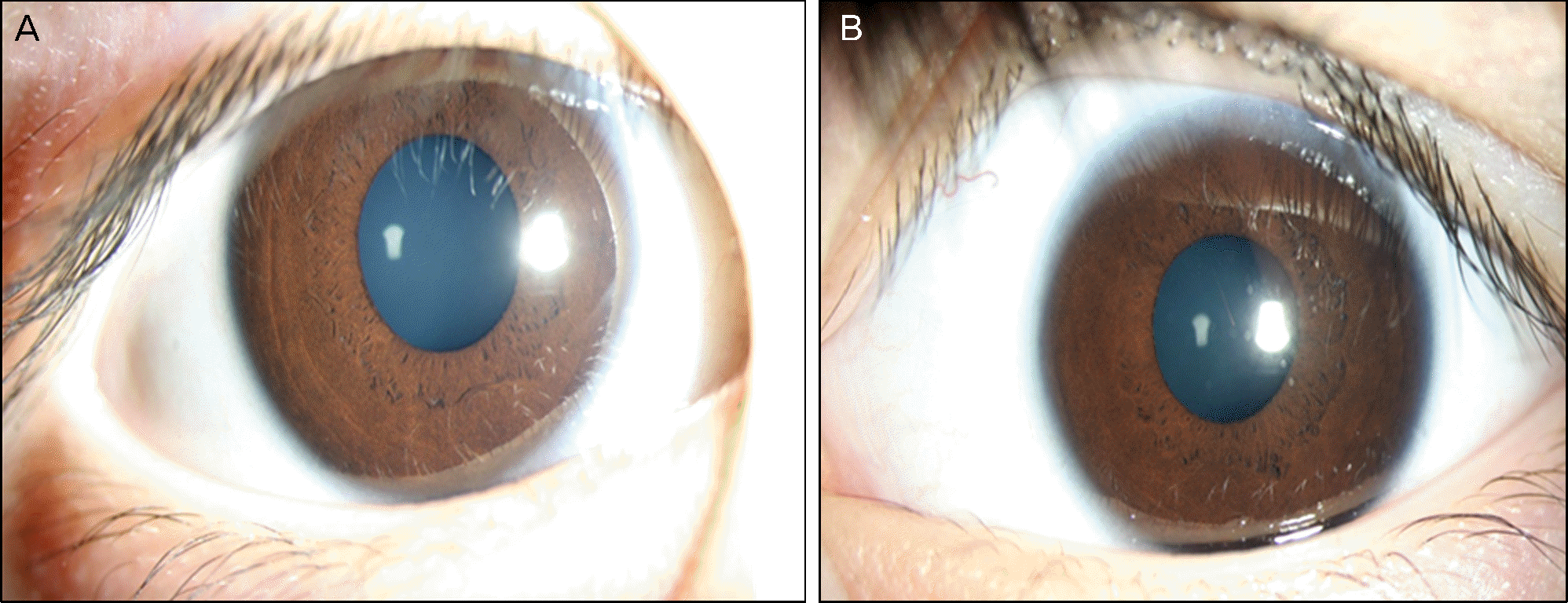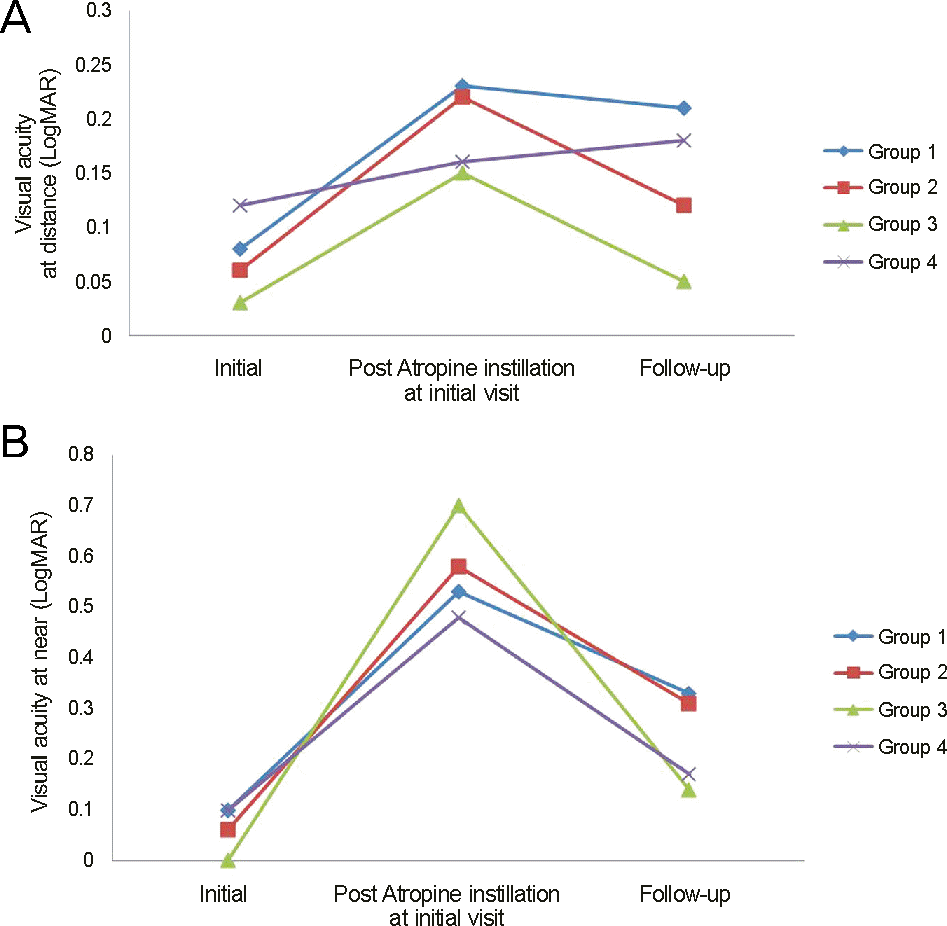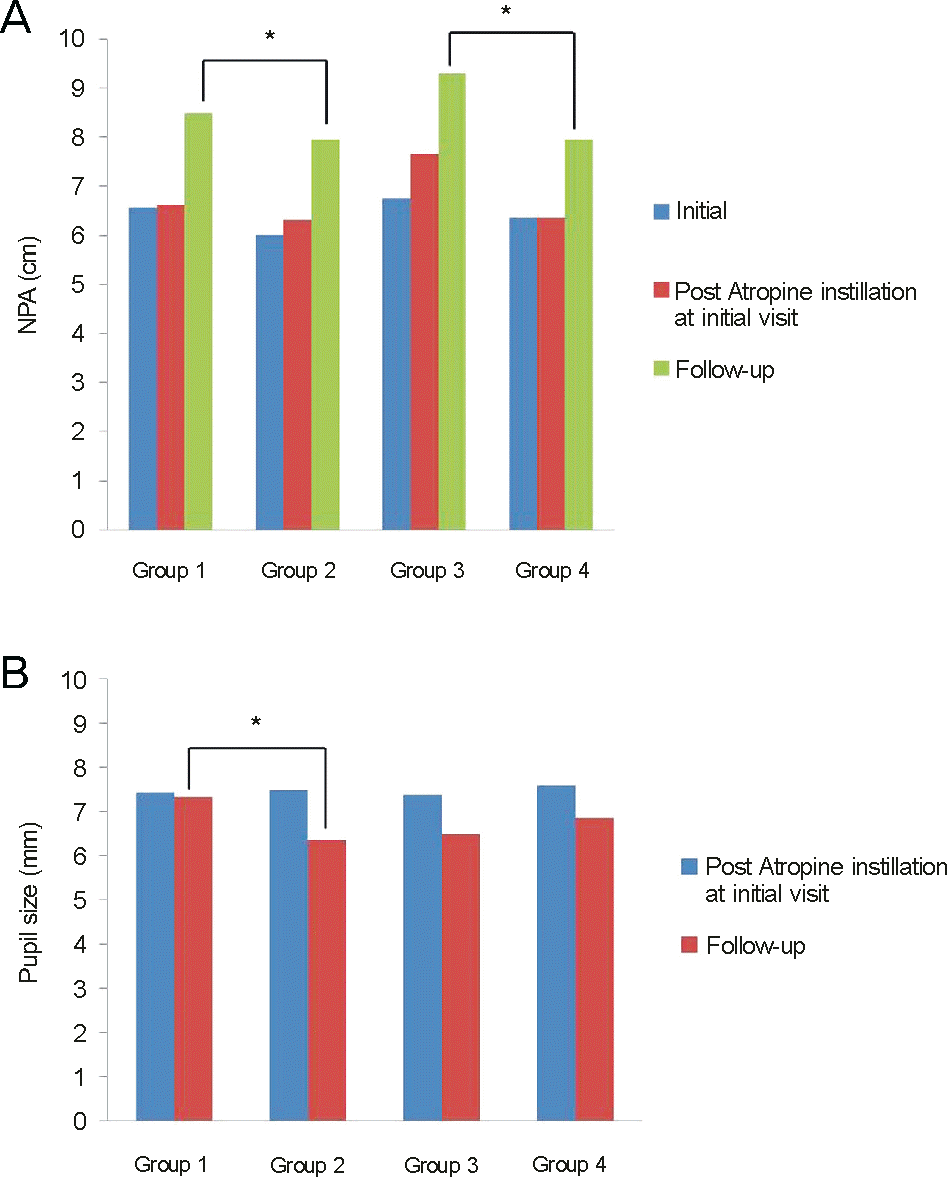Abstract
Methods
Distant and near visual acuity, near point of accommodation (NPA), and pupil size were measured in the sound eye of 40 children with amblyopia before and after receiving atropine sulfate 1% solution. Amblyopic children were divided into 2 groups according to the time of follow-up visit: 4-days and 7-days after injection; the same tests were performed on all the scheduled follow-up visits. This study included a control group of 20 normal children who received the same test on the initial visit and the scheduled follow-up visits.
Results
Visual acuity of the sound eye at distance showed greater decreases in children with 4-day follow-up visits compared with 7-day visits in the amblyopic group (p = 0.24). There was no significant difference in near visual acuity between the amblyopic group and the normal control group by follow-up interval (p = 0.98, p = 0.75). Near point of accommodation significantly increased in the 4-day visit group in both the amblyopic and the normal control groups (p = 0.04 and p = 0.03, respectively), Pupil size was significantly maintained in the 4-day visit, amblyopic group (p = 0.01).
Go to : 
References
1. Friedman Z, Neumann E, Hyams SW, Peleg B. Ophthalmic screening of 38,000 children, age 1 to 2 1/2 years, in childwelfare clinics. J Pediatr Ophthalmol Strabismus. 1980; 17:261–7.
2. Simons K. Preschool vision screening: rationale, methodology and outcome. Surv Ophthalmol. 1996; 41:3–30.

3. Vereecken EP, Brabant P. Prognosis for vision in amblyopia after the loss of the good eye. Arch Ophthalmol. 1984; 102:220–4.

4. Kaye SB, Chen SI, Price G, et al. Combined optical and atropine penalization for the treatment of strabismic and anisometropic amblyopia. J AAPOS. 2002; 6:289–93.

5. Kaye SB, Chen SI, price G, et al. Combined optical and atropine penalization for the treatment of strabismic and anisometropic amblyopia. J AAPOS. 2002; 6:289–93.

6. Searle A, Norman P, Harrad R, Vedhara K. Psychosocial and clinical determinants of compliance with occlusion therapy for amblyopic children. Eye (Lond). 2002; 16:150–5.

7. Woodruff G, Hiscox F, Thompson JR, Smith LK. Factors affecting the outcome of children treated for amblyopia. Eye (Lond). 1994; 8:627–31.

8. Beardsell R, Clarke S, Hill M. Outcome of occlusion treatment for amblyopia. J Pediatr Ophthalmol Strabismus. 1999; 36:19–24.

9. Simons K, Gotzler KC, Vitale S. Penalization versus part-time occlusion and binocular outcome in treatment of strabismic amblyopia. Ophthalmology. 1997; 104:2156–60.

10. Pediatric Eye Disease Investigator Group. A randomized trial of atropine regimens for moderate amblyopia in children. Ophthalmology. 2004; 111:2076–85.
11. Foley-Nolan A, McCann A, O'keefe M. Atropine penalization versus occlusion as the primary treatment for amblyopia. Br J Ophthalmol. 1997; 81:54–7.
12. Epelbaum M, Milleret C, Buisseret P, Dufier JL. The sensitive period for strabismic amblyopia in humans. Ophthalmology. 1993; 100:323–7.

13. Marron J. Cycloplegia and mydriasis by use of atropine, scopol-amine and homatropine-paredrine. Arch Ophthalmol. 1940; 23:340–50.

14. Miranda MN. Residual accomodation. A comparison between cyclopentolate 1% and a combination of cyclopentolate 1% and tropi-camide 1%. Arch Ophthalmol. 1972; 87:515–7.
15. Zetterström C. A cross-over study of cycloplegic effects of a single topical application of cyclopentolate-phenylephrine and routine atropinisation for 3.5 days. Acta Ophthalmol. 1985; 63:525–9.
16. Milder B, Riffenburgh RS. An evaluation of cyclogyl (compound 75 GT). Am J Ophthalmol. 1953; 36:1724–6.

17. Priestley B, Medine MM. New mydriatic and cycloplegic drug. Am J Ophthalmol. 1951; 34:638–9.
19. Pediatric Eye Disease Investigator Group. A randomized trial of atropine vs. patching for treatment of moderate amblyopia in children. Arch Ophthalmol. 2002; 120:268–78.
20. Scott WE, Dickey CF. Stability of visual acuity in amblyopic patients after visual maturity. Graefes Arch Clin Exp Ophthalmol. 1988; 226:154–7.

21. Park SH, Yoon IN, Rah SH. The effect of atropinization of refractive accommodative esotropia patients with amblyopia. J Korean Ophthalmol Soc. 2003; 44:2292–8.
22. Ahn HB, Yoo KW, Rho SH. The cycloplegic effect of atropine. J Korean Ophthalmol Soc. 1995; 36:2029–34.
23. Flynn JT, Schiffman J, Feuer W, Corona A. The therapy of amblyopia: an analysis of the results of amblyopia therapy utilizing the pooled data of published studies. Trans Am Ophthalmol Soc. 1998; 96:431–50.
24. Park SC, Lee KH, Lee JR. Clinical approach for visual achievement in amblyopia treatment. J Korean Ophthalmol Soc. 1991; 32:802–8.
Go to : 
 | Figure 1.A 6-years-old female child, after 7 days atropine instillation on right sound eye. Compared with left amblyopic eye (B), pupil of right sound eye (A) did not nearly dilate and showed an intact light reflex on light condition. |
 | Figure 2.Change of visual acuity in amblyopic and normal children at distance (A), at near (B). Group 1 = 4-days fol-low-up, amblyopic children; Group 2 = 7-days follow-up, amblyopic children; Group 3 = 4-days follow-up, normal children; Group 4 = 7-days follow-up, normal children. |
 | Figure 3.Change of NPA (A) and pupil size (B) in amblyopic and normal children. NPA = near point of accommodation; Group 1 = 4-days follow-up, amblyopic children; Group 2 = 7-days follow-up, amblyopic children; Group 3 = 4-days fol-low-up, normal children; Group 4 = 7-days follow-up, normal children. * Statistically significant difference between two groups. |
Table 1.
Baseline characteristics of the amblyopic and normal subjects
| Variables (years) |
Amblyopia |
Normal |
p-value* | ||
|---|---|---|---|---|---|
| 4-days F/U (Group 1) | 7-days F/U (Group 2) | 4-days F/U (Group 3) | 7-days F/U (Group 4) | ||
| Subjects (eyes) | 20 | 20 | 10 | 10 | |
| Sex (male/female) | 12/8 | 10/10 | 5/5 | 5/5 | 0.88* |
| Age (years) | 6.60 ± 2.14 | 6.40 ± 2.35 | 6.90 ± 2.28 | 5.00 ± 2.30 | 0.14* |
| Initial distance VA (log MAR) | 0.08 ± 0.19 | 0.06 ± 0.08 | 0.03 ± 0.05 | 0.12 ± 0.31 | 0.36† |
| Initial near VA (log MAR) | 0.10 ± 0.19 | 0.06 ± 0.12 | 0.00 ± 0.00 | 0.10 ± 0.22 | 0.41† |
| Initial NPA (cm) | 6.58 ± 1.72 | 6.00 ± 1.56 | 6.75 ± 1.51 | 6.35 ± 1.58 | 0.59† |
Table 2.
Change of visual acuity and NPA, pupil size in amblyopic and normal children after Atropine instillation
| Variables |
Amblyopia |
p-value |
Normal |
p-value | ||
|---|---|---|---|---|---|---|
| 4-days F/U (Group 1) | 7-days F/U (Group 2) | 4-days F/U (Group 3) | 7-days F/U (Group 4) | |||
| Initial distance VA (log MAR) | 0.08 ± 0.19 | 0.06 ± 0.08 | 0.38† | 0.03 ± 0.05 | 0.12 ± 0.31 | 0.09† |
| Initial near VA (log MAR) | 0.10 ± 0.19 | 0.06 ± 0.12 | 0.70† | 0.00 ± 0.00 | 0.10 ± 0.22 | 0.28† |
| Initial NPA (cm) | 6.58 ± 1.72 | 6.00 ± 1.56 | 0.81* | 6.75 ± 1.51 | 6.35 ± 1.58 | 0.94* |
| Post 1 hour distance VA (log MAR) | 0.23 ± 0.17 | 0.22 ± 0.17 | 0.95† | 0.15 ± 0.11 | 0.16 ± 0.20 | 0.19† |
| Post 1 hour near VA (log MAR) | 0.53 ± 0.28 | 0.58 ± 0.40 | 0.80† | 0.70 ± 0.33 | 0.48 ± 0.44 | 0.32† |
| Post 1 hour NPA (cm) | 6.63 ± 1.92 | 6.30 ± 1.81 | 0.86* | 7.65 ± 1.70 | 6.35 ± 1.62 | 0.81* |
| Post 1 hour pupil size (mm) | 7.43 ± 0.57 | 7.50 ± 0.67 | 0.36* | 7.40 ± 0.46 | 7.60 ± 0.88 | 0.12* |
| Follow-up distance VA (log MAR) | 0.21 ± 0.21 | 0.12 ± 0.13 | 0.24† | 0.05 ± 0.08 | 0.18 ± 0.18 | 0.10† |
| Follow-up near VA (log MAR) | 0.33 ± 0.32 | 0.31 ± 0.32 | 0.98† | 0.14 ± 0.08 | 0.17 ± 0.29 | 0.75† |
| Follow-up NPA (cm) | 8.50 ± 2.76 | 7.95 ± 1.78 | 0.04* | 9.30 ± 3.95 | 7.95 ± 2.36 | 0.03* |
| Follow-up pupil size (mm) | 7.33 ± 0.54 | 6.35 ± 1.08 | 0.01* | 6.50 ± 0.97 | 6.85 ± 0.91 | 0.55* |




 PDF
PDF ePub
ePub Citation
Citation Print
Print


 XML Download
XML Download